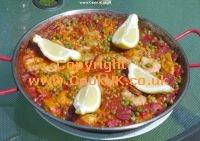
This page lists all our paella recipes in one place
but take time to read our three associated articles which
explain in detail the golden rules behind making paella. |
|
CLICK ANY PICTURE ON THIS PAGE TO ENLARGE IT
COOKUK PAELLA RECIPES
Get the basic principles of
a paella correct and you can add a huge variety of ingredients,
seafood, meats and vegetables are the common additional
ingredients. Our paella recipes below show only a fraction of
what is possible with paellas so experiment for yourself.
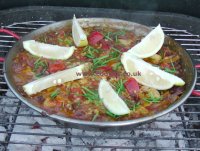 |
Chicken
and Chorizo Paella
This is our favourite version of paella, the chicken and
chorizo go together so well. Yes we know it's not the
traditional paella but it's a delight for the taste buds. |
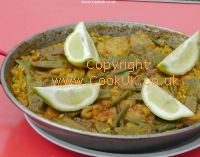 |
Valencian Paella
The original paella from the Valencia region of Spain. Chicken,
rabbit or snails are the traditional meats but we stick to just
chicken. Add a variety of beans with some herbs and spices for a
delicious paella. |
 |
Chorizo and
King Prawn Paella
Paella is all about the rice, the accompanying veg, seafood and
meats are simply there to add flavour to the rice. Chorizo
does exactly that and compliments the rice perfectly. |
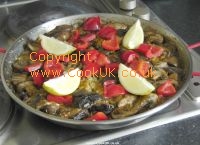 |
Mushroom Paella
One of the easier paellas to cook but it has lots of flavour and
with a few red peppers squares it looks the part as well. One of
the classic paellas. |
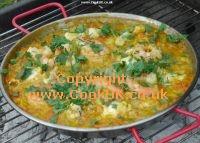 |
Seafood Paella
A delicious, simple paella recipe which uses monkfish and
king prawns. |
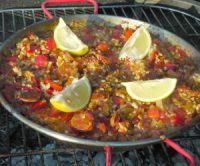 |
Pork and Chorizo Paella
Traditional paella rice and vegetables combined with not so
traditional pork and chorizo for a delicious paella. |
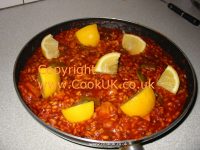 |
Chicken
Paella
Sometimes you may just want a chicken paella with no other added
ingredients - here it is! |
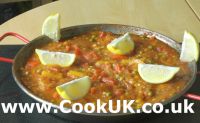 |
Vegetable Paella
The sofrito (base sauce) is the key to a good vegetable
paella. Get that right and you have a super-tasty paella. We
explain exactly how to do that in easy steps. |
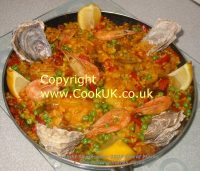 |
Traditional Paella
Here is a recipe for the paella traditionally served in many
cheap bars. Not really a true paella but it tastes good to us. |
THE PAELLA PAN
A good paella pan is essential if you want an authentic paella.
That's not to say that can't make a tasty paella in a frying pan
/ skillet but it will not be quite the same as the traditional
paella. A good pan encourages even cooking of the rice and the
formation of socarrat - the slightly crusty layer at the
base of a good paella. Click here
for lots more information on paella pans.
We are frequently asked where good equipment (paella pans,
suitable gas burners, ingredients etc.) can be bought. For most
of us the solution is online and
Paella World is a
good place to start.
PAELLA RICE
Paella is all about the rice and the flavours it takes on when
mixed with other ingredients. The chicken pieces, fish, chorizo
or whatever else is added are tasty but the star of the show is
definitely the rice.
It makes sense therefore, to use the best rice for a paella and
that is paella rice. The outside of the rice softens but the
inside of the grains retains an almost nutty texture. Different
from risotto rice and most definitely different to long grain
rice. Read more in our definitive article on types of paella
rice by clicking here.
THE BASE SAUCE OR SOFRITO
All good paellas have a base sauce which consists of ripe plum
tomatoes, onion and garlic. Other ingredients are added
according to regional variations and whatever is in season,
paprika and rosemary are frequent additions. Cook
the sofrito on a lowish heat until the moisture is
reduced and the mixture stacks up in the pan.
When the rice is added to the paella pan it should be added
directly to the sofrito and then stirred round in it to
make sire all the rice is well coated in the mixture.
OTHER ELEMENTS
There are a number of other elements to a good paella which vary
little whatever recipe is used. First, where any of the
ingredients are sautéed, good quality Spanish virgin olive oil
is used. This is more about tradition rather than taste because
Spanish olive oil varies dependant on the region of production.
A good quality Greek or Italian virgin olive
oil will do just as well.
When the rice is added to the sofrito some form of
additional liquid will be needed so that the rice can absorb it.
If a good sofrito has been prepared then water is the
preferred liquid in Spain. Stock, either fresh or canned will
add further flavour
Saffron is a key ingredient to many paella recipes, it colours
the rice and gives the paella a delicate background flavour.
Read our detailed article on saffron
and how to use it in cooking.
Finally, when all the cooking is complete the paella is taken
off the heat and rested for five minutes or so. This ensures the
rice is fully cooked and settles down. Cover with a towel or
similar during this time to retain heat and keep the paella
clean.
BACK TO SPANISH RECIPES HOME PAGE
| 
